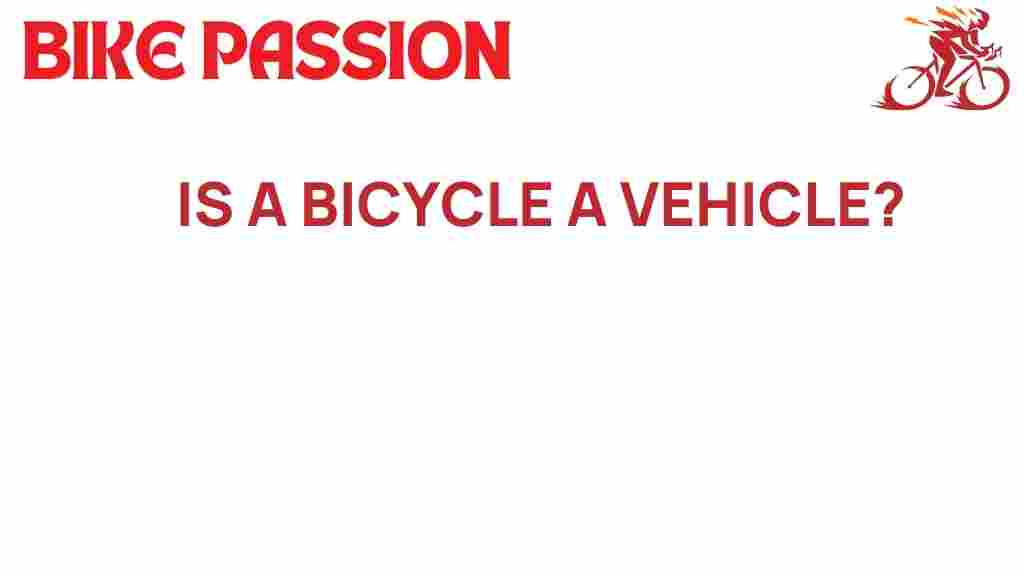Is a Bicycle a Vehicle? Understanding Vehicle Classification
Bicycles have been a staple of transportation for centuries, providing mobility and freedom to millions. But the question remains: is a bicycle truly classified as a vehicle? This article dives deep into the definitions, implications, and regulations surrounding bicycles as vehicles. We will explore the legal context, safety considerations, and infrastructure challenges that come into play in the world of cycling.
The Definition of a Vehicle
To understand whether a bicycle qualifies as a vehicle, we first need to clarify what constitutes a vehicle. Generally, a vehicle is defined as a machine, often with wheels, that is used for transporting people or goods. This definition can vary by jurisdiction, especially when it comes to laws and regulations.
In many legal contexts, the term “vehicle” includes:
- Cars
- Trucks
- Buses
- Motorcycles
- Bicycles
Given this broad definition, bicycles are frequently included in transportation laws. However, the specifics can differ significantly between regions.
Legal Perspective on Bicycles as Vehicles
The classification of bicycles as vehicles has significant implications for cyclists regarding laws and regulations. In many places, bicycles are subject to the same traffic laws as motor vehicles, which includes:
- Obeying traffic signals
- Riding in the same direction as traffic
- Using designated bike lanes where available
However, there are areas where bicycles are treated differently. For example:
- Some jurisdictions have specific laws governing the operation of bicycles.
- In some regions, cyclists may not be required to wear helmets.
- There are often different penalties for infractions involving bicycles compared to motor vehicles.
It’s important for cyclists to be aware of local laws to ensure compliance and enhance safety.
Transportation and Mobility: The Role of Bicycles
Bicycles play a crucial role in urban transportation and mobility. They offer numerous benefits, including:
- Eco-Friendly: Bicycles have a minimal carbon footprint compared to motor vehicles.
- Cost-Effective: Cycling is often cheaper than car ownership and public transport.
- Health Benefits: Regular cycling can improve physical health and mental well-being.
- Traffic Alleviation: More bicycles on the road can reduce congestion.
In many cities, promoting cycling as a viable mode of transportation is gaining traction, leading to the development of better infrastructure and facilities for cyclists.
Infrastructure for Bicycles
The effectiveness of bicycles as a mode of transportation heavily relies on infrastructure. Well-designed bicycle infrastructure includes:
- Bicycle lanes: Dedicated lanes that separate cyclists from motor vehicle traffic.
- Bicycle parking: Secure and accessible places to park bicycles.
- Bike-sharing programs: Systems that allow users to rent bicycles for short periods.
Investing in bicycle infrastructure not only supports cyclists but also enhances overall urban mobility. However, the challenges of integrating bicycles into existing transportation systems must be addressed to ensure safety and efficiency.
Safety Concerns for Cyclists
While cycling is a healthy and environmentally friendly choice, safety is a major concern. Statistics show that cyclists are at a higher risk of accidents compared to motorists. To improve safety, cyclists are encouraged to follow these guidelines:
- Wear a Helmet: A helmet can significantly reduce the risk of head injuries.
- Use Lights and Reflectors: Make yourself visible, especially at night.
- Follow Traffic Laws: Obey all traffic signals and signs.
- Stay Alert: Always be aware of your surroundings and anticipate the actions of other road users.
By adhering to safety protocols, cyclists can reduce their risk of accidents and enjoy a safer riding experience.
Step-by-Step Guide to Cycling Safely
To ensure a safe and enjoyable cycling experience, follow this step-by-step guide:
- Inspect Your Bicycle: Before every ride, check the brakes, tires, and chain.
- Plan Your Route: Choose bike-friendly roads and paths to avoid heavy traffic.
- Dress Appropriately: Wear bright clothing and a helmet.
- Signal Your Intentions: Use hand signals to indicate turns and stops.
- Stay Focused: Avoid distractions such as mobile phones while riding.
Troubleshooting Common Cycling Issues
Even seasoned cyclists may encounter common issues. Here are some troubleshooting tips:
- Punctured Tire: Carry a repair kit to fix flats on the go.
- Brake Issues: Regularly check and adjust brakes for optimal performance.
- Chain Problems: Keep the chain lubricated and clean to avoid jamming.
Regular maintenance and carrying basic repair tools can help you address these issues quickly and effectively.
The Future of Bicycles in Transportation
The future of bicycles as vehicles in urban transportation looks promising. With growing awareness of environmental issues and urban congestion, many cities are investing in cycling infrastructure. Innovations such as electric bicycles and improved bike-sharing programs further enhance the appeal of cycling.
Additionally, as more people turn to cycling for commuting, it is essential to continue advocating for safe cycling laws and better infrastructure. Community education and engagement can also play a significant role in promoting cycling as a mainstream mode of transportation.
Conclusion: Bicycles as Vehicles
In summary, bicycles are indeed classified as vehicles in many legal contexts, and they play a vital role in transportation and mobility. Understanding the laws and regulations surrounding cycling is crucial for cyclists to ensure safety and compliance. Furthermore, investing in infrastructure and promoting safe cycling practices can significantly enhance the cycling experience.
As society continues to embrace cycling for its numerous benefits, the classification of bicycles as vehicles will likely remain important in shaping future transportation policies and practices. For more information on cycling laws and regulations, you can visit the National Highway Traffic Safety Administration.
By recognizing bicycles as vehicles, we can create a more inclusive and sustainable transportation ecosystem that benefits everyone.
This article is in the category Tech and created by BikePassion Team
